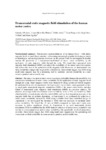Mostrar o rexistro simple do ítem
Transcranial static magnetic field stimulation of the human motor cortex
| dc.contributor.author | Oliviero, Antonio | |
| dc.contributor.author | Mordillo-Mateos, Laura | |
| dc.contributor.author | Arias, Pablo | |
| dc.contributor.author | Panyavin, Ivan | |
| dc.contributor.author | Foffani, Guglielmo | |
| dc.contributor.author | Aguilar, Juan | |
| dc.date.accessioned | 2015-04-29T08:22:45Z | |
| dc.date.available | 2015-04-29T08:22:45Z | |
| dc.date.issued | 2001-08-01 | |
| dc.identifier.citation | Oliviero A, Mordillo-Mateos L, Arias P, Panyavin I, Foffani G, Aguilar J. Transcranial static magnetic field stimulation of the human motor cortex. J Physiol. 2011;589(20):4949-4958. | es_ES |
| dc.identifier.uri | http://hdl.handle.net/2183/14460 | |
| dc.description.abstract | [Abstract] The aim of the present study was to investigate in healthy humans the possibility of a non-invasive modulation of motor cortex excitability by the application of static magnetic fields through the scalp. Static magnetic fields were obtained by using cylindrical NdFeB magnets. We performed four sets of experiments. In Experiment 1, we recorded motor potentials evoked by single-pulse transcranial magnetic stimulation (TMS) of the motor cortex before and after 10min of transcranial static magnetic field stimulation (tSMS) in conscious subjects. We observed an average reduction of motor cortex excitability of up to 25%, as revealed by TMS, which lasted for severalminutes after the end of tSMS, andwas dose dependent (intensity of the magnetic field) but not polarity dependent. In Experiment 2, we confirmed the reduction of motor cortex excitability induced by tSMS using a double-blind sham-controlled design. In Experiment 3, we investigated the duration of tSMS that was necessary to modulate motor cortex excitability. We found that 10 min of tSMS (compared to 1min and 5 min) were necessary to induce significant effects. In Experiment 4, we used transcranial electric stimulation (TES) to establish that the tSMS-induced reduction ofmotor cortex excitability was not due to corticospinal axon and/or spinal excitability, but specifically involved intracortical networks. These results suggest that tSMS using small static magnets may be a promising tool to modulate cerebral excitability in a non-invasive, painless, and reversible way. | es_ES |
| dc.language.iso | eng | es_ES |
| dc.publisher | Wiley | es_ES |
| dc.relation.uri | http://dx.doi.org/10.1113/jphysiol.2011.211953 | es_ES |
| dc.rights | This is the peer reviewed version of the following article, which has been published in final form at Wiley Online Library. This article may be used for non-commercial purposes in accordance with Wiley Terms and Copnditions for self-archiving. | es_ES |
| dc.title | Transcranial static magnetic field stimulation of the human motor cortex | es_ES |
| dc.type | info:eu-repo/semantics/article | es_ES |
| dc.rights.access | info:eu-repo/semantics/openAccess | es_ES |
Ficheiros no ítem
Este ítem aparece na(s) seguinte(s) colección(s)
-
GI-NEURO - Artigos [132]






